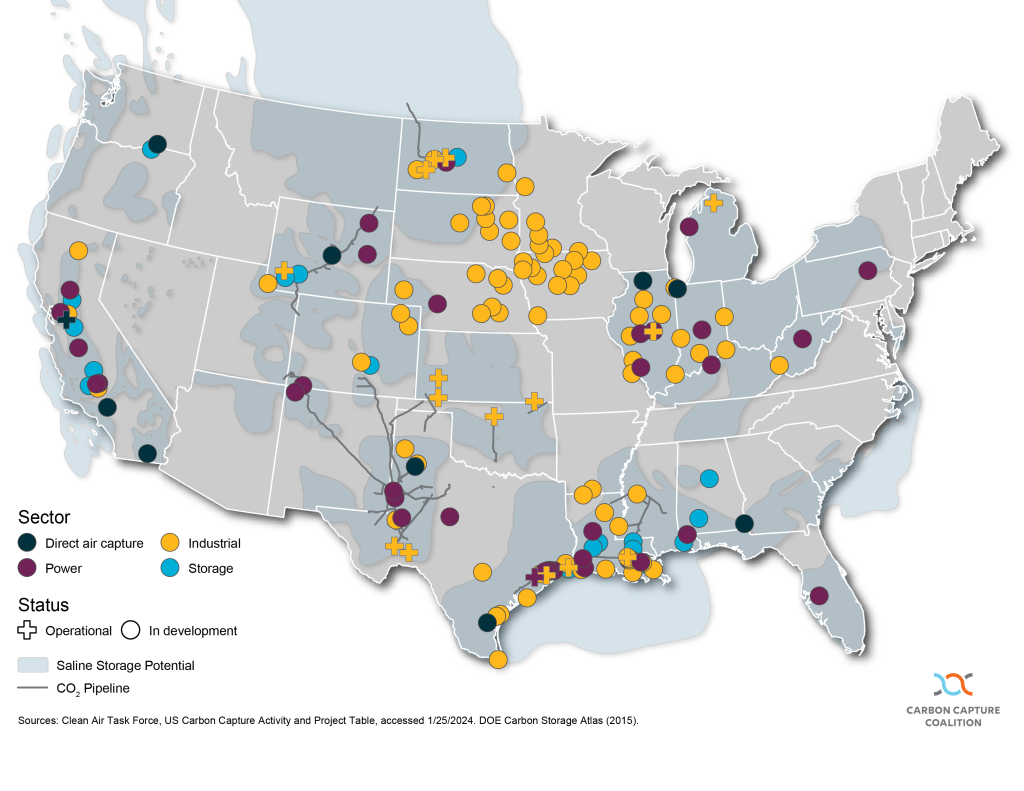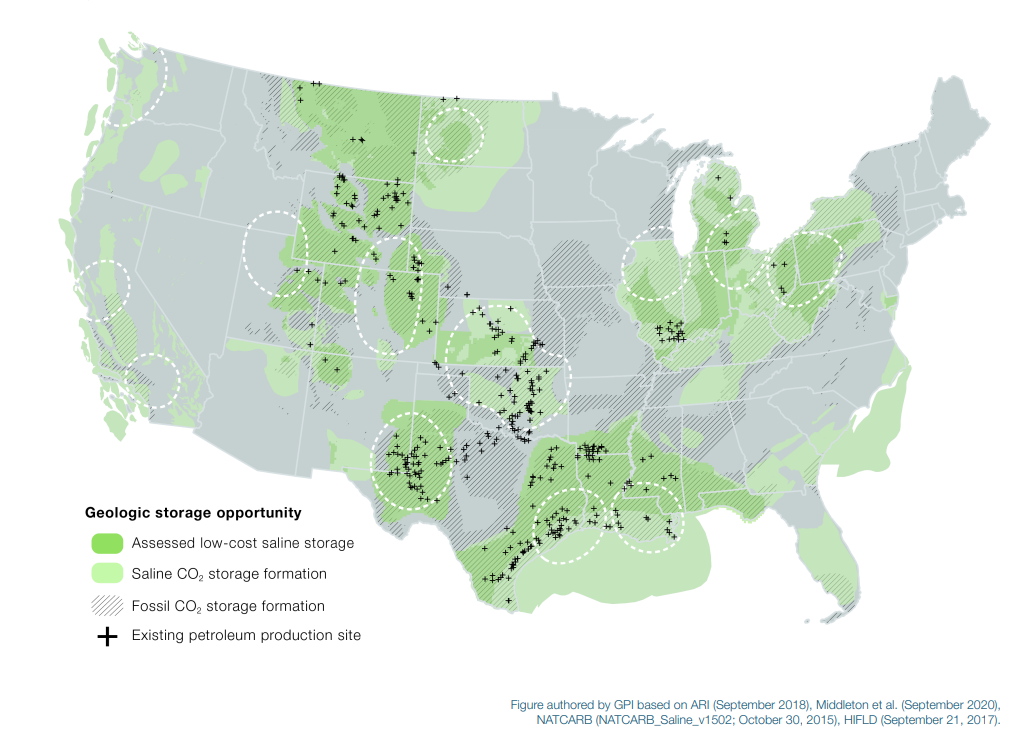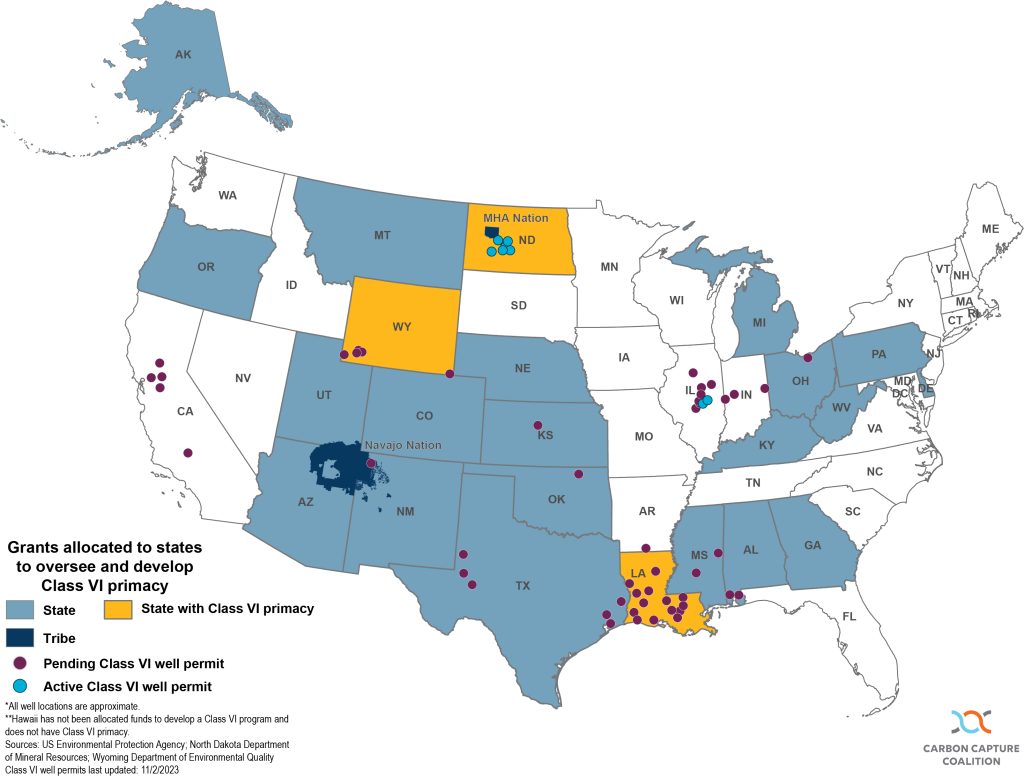Geologic Storage’s Role in Scaling Carbon Management
February 8, 2024 | Blog
Introduction
Commercial interest in carbon management technologies is growing rapidly thanks to robust and bipartisan federal support for economywide deployment of these climate-essential technologies, including the historic investments made in the Bipartisan Infrastructure Law and the essential enhancements to the federal Section 45Q tax credit enacted in 2022. Nearly 200 projects have been announced in the US since the significant restructuring and expansion of the federal Section 45Q tax credit in 2018, with 59 announced in 2023 alone. These projects span the carbon management value chain – from capturing carbon from industry and power to directly from the atmosphere – as well as stages of project development – from pilot scale and feasibility up to commercial scale projects.
Most announced capture and removal projects intend to store captured carbon dioxide (CO2) deep underground safely and permanently in saline geologic formations. If the carbon management industry is to make meaningful contributions to meeting emissions reduction goals and climate targets, as intended, storage infrastructure must scale to millions of metric tons per year of commercially available secure geologic storage. While the United States has abundant appropriate and well-characterized geology for safe and permanent storage of captured CO2, additional policy development is needed at the federal and state levels to ensure we can capitalize on these domestic resources. As we continue to see a steady stream of project announcements in direct response to the recent wave of federal policy support, it is essential that the supportive infrastructure, permitting, and regulatory regime required to enable the growth of this industry are in place with the resources and staffing needed to execute these projects.

Figure 1: Announced carbon management projects in the United States as of January 2024.
Put simply, timely and rigorous permitting of appropriate geologic storage by state and federal regulators is the lynchpin in scaling safe, reliable, and permanent sites for geologic storage of captured CO2. Here are a few key takeaways to ensure that geologic storage capacity can scale to meet the anticipated need from announced projects:
- Saline geologic formations are essential to successfully deploying carbon management technologies at the rate and scale necessary to meet US and global climate goals. Even with complementary efforts of nascent carbon utilization technologies, safe and permanent storage of captured CO2 is a critical tool the US and the globe must deploy to help mitigate the worst impacts of our changing climate.
- Federal and state authorities are central to ensuring safe and permanent geologic storage in saline formations through a robust system of monitoring, verification, and reporting, overseen by the US Environmental Protection Agency’s (EPA) Underground Injection Control (UIC) Program for Class VI injection wellsor by states that have been delegated primary enforcement authority – or primacy – over Class VI wells.
- Project developers and communities could benefit from tremendous economic and job opportunities in carbon management project deployment, thanks to sustained federal investments in the technology, geologic storage, and industrial decarbonization in recent legislation.
- Robust federal funding enacted as part of annual appropriations and the Bipartisan Infrastructure Law (BIL) will provide essential support for project deployment, including by expanding the capacity of federal and state authorities to permit geologic storage in saline formations and providing funds for further geologic storage site characterization.
Scaling Geologic Storage is Central to Enabling Carbon Management’s Role in Meeting Climate Goals
Economywide deployment of commercial-scale carbon management technologies is needed to meet midcentury global temperature targets, including carbon capture retrofits of industrial facilities and power plants and direct air capture (DAC) facilities that remove CO2 directly from the atmosphere. The IEA’s Net Zero Emissions by 2050 scenario estimates that the current slate of projects under development globally will capture and store about 40 million tons of CO2 in the next five years. That number must increase to 1.6 gigatons (or billion tons) by 2030 and 7.6 gigatons by midcentury to reach net zero emissions.
The International Panel on Climate Change (IPCC) released its Summary for Policymakers of the Sixth Assessment Synthesis Report in early 2023. The report reconfirmed the essential role of carbon management technologies in meeting net zero emissions targets by midcentury, reaffirming the complementary and critical role that carbon management will play in limiting warming to 1.5˚C across various sectors. The report noted carbon management as a “critical area” to “preserve a reasonable chance of limiting global temperature rise to 1.5˚C by 2100”.
Fortunately, the carbon management industry is poised to capture and abate millions of metric tons of CO2 over the course of this decade, thanks in large part to significant federal investment over the past several years. The 117th Congress enacted the most forward-looking policies in the world for carbon management, driving additional project deployment and significant private investment in the sector. Thanks to this broad bipartisan support, more and more projects are being announced each month, signaling that increased federal policy support for carbon management technologies will translate into real-world projects.
However, to sustain the increase in project announcements and catalyze the deployment of a mature domestic carbon management industry, Congress must address the gaps in federal carbon management policy that remain to build sufficient market demand for this broad suite of technologies. Building upon a strong foundation of federal policy support, policymakers across the government must also work with federal agencies to provide the necessary regulatory framework and ensure swift and effective implementation of enacted legislation. These priorities are articulated in the Carbon Capture Coalition’s 2023 Policy Blueprint.
US Has Ample Capacity to Safely, Permanently Store Captured CO2 in Geologic Formations
The United States’ geology offers vast potential to permanently and securely store captured carbon deep underground in appropriate geologic formations, as detailed in the US Department of Energy (DOE) Carbon Storage Atlas. As such, safe and permanent injection and storage of CO2 in deep geologic formations represents a well-understood commercial practice worldwide.
The longest operating CO2 storage facility, the Sleipner carbon capture and storage project operating offshore of Norway in the North Sea, has safely and permanently stored about one million metric tons of CO2 annually since storage operations began in 1996.
Here in the US, DOE has been studying and field-testing geologic storage for over 20 years in addition to more than fifty years of experience storing CO2 in oil and gas fields. Their work has overwhelmingly demonstrated that geologic storage of CO2 is a safe and permanent practice with a very low risk of CO2 migrating outside the target formation when properly sited and carried out. To that point, no DOE-supported storage project has “observed migration of CO2” outside the intended storage formation.
According to DOE, the country’s geologic storage capacity is anywhere from 2.2 trillion to 21.2 trillion metric tons of CO2. For context, US greenhouse gas emissions totaled approximately 6,340 million metric tons of CO2 in 2021; in essence, we won’t run out of available geologic storage. The Great Plains Institute’s (GPI) Atlas of Carbon and Hydrogen Hubs illustrates the potential opportunities in regions across the country for locating carbon capture, DAC, and carbon storage. GPI identified 542 industrial and power facilities that are near- and medium-term opportunities for installing carbon capture technologies based on each facility’s 45Q eligibility and emissions profile. While some of this CO2 will be reused to manufacture value-added commercial products, these facilities and emissions represent the potential to capture and store hundreds of millions of metric tons of CO2 emissions per year from existing industry and power sources by 2035.

Figure 2: Saline geologic storage opportunities in the US
GPI’s 2023-released Atlas of Direct Air Capture identifies critical regions in the US that are prime locations for the development of DAC hubs based on an analysis of suitability factors, including proximity to and availability of appropriate geologic storage. Direct air capture is a subset of a more extensive suite of carbon removal technologies that can remove CO2 directly from the atmosphere. Currently, 18 direct air capture plants operate worldwide, capturing 10,000 tons of CO2 per year— notably, these facilities are pilot-scale, with the exception of Climeworks’ Orca project, the world’s first commercial-scale DAC facility, located in Iceland. Additionally, the 1PointFive direct air capture facility began construction in late 2022 in the United States and is expected to capture up to 500,000 metric tons of CO2 per year, with the ability to scale up to capture one million metric tons per year. While this progress is encouraging, to meet net zero by midcentury, according to the IEA, this nascent but essential sector must be scaled up globally to capture more than 85 million tons of CO2 per year in 2030 and nearly one gigatonof CO2 per year by 2050.
To tap into these domestic geologic storage opportunities and develop carbon storage to climate-scale, carbon management projects must comply with federal regulations at the US EPA or relevant state agency who has authority over geologic storage. Ultimately, the success of these storage opportunities hinges upon obtaining Class VI injection wells.
Underground Injection Wells and How They’re Regulated
Injection wells are used to send fluids underground into porous geologic formations, such as deep sandstone or limestone layers. Two EPA-regulated well classes cover CO2 injection projects: Class II and Class VI.
The EPA, through the Underground Injection Control (UIC) Program, regulates more than 740,000 injection wells in operation across the United States that are used for a variety of purposes to ensure the safety of underground sources of drinking water. The EPA administers the UIC program through work with states, tribes, and local officials.
Class II wells are used to inject fluids (e.g., CO2 and wastewater) associated with oil and natural gas production. Geologic storage of CO2 in such operations can be incidental, meaning that permanent storage of CO2 can occur in the context of injection undertaken principally for other commercial purposes. While the carbon management industry has historically been focused on using Class II wells to store captured CO2, thanks to the incentive structure in place now under 45Q, most recently announced carbon capture and direct air capture projects intend to store captured CO2 in saline geologic formations, which are categorized as Class VI wells.
Class VI wells are used to inject CO2 into deep geologic formations solely for the purpose of permanently storing CO2, which is often referred to as dedicated storage. EPA established this well class separately from Class II to provide specific regulations for projects where the purpose is dedicated geologic storage. EPA tailored Class VI program rules to address the permanent storage of CO2 and ensure that wells are appropriately sited, constructed, tested, monitored, funded, and closed once injection activities are completed.
Project developers looking to store CO2 securely and permanently underground must receive permits for Class VI wells and are unable to move forward on developing carbon storage projects and injecting captured carbon into the ground until they receive necessary approvals from EPA or the relevant state, territory, or tribe that’s been granted primary enforcement authority, referred to as primacy, by EPA over these well applications.
Class VI Primacy: The Role of States in UIC Program Implementation
EPA can grant primacy to individual states, territories, or Tribal nations, which delegates authority to these governments to oversee and approve permits for certain well classes regulated under the UIC program in accordance with federal standards. States, territories, or Tribal nations can be approved for primacy only if their regulations meet or exceed the EPA’s UIC program regulations.
State primacy is a common practice for other well classes, with most states having primacy for well classes I through V. Nearly all US states – 43 – have primacy over at least one well class. Implementation of the Class II program has been delegated to many states since the early 1980s, with EPA retaining primary enforcement authority for all remaining states.
EPA has delegated primary enforcement authority for Class VI wells to three states: North Dakota, Wyoming, and most recently Louisiana. Arizona, West Virginia, and Texas are listed as being in the “pre-application” phase. Once states receive primacy, the EPA reviews primacy programs through regular communications with state permitting agencies.
To date, the EPA has permitted four Class VI wells with draft permits for four additional wells pending. With the influx of project announcements over the last several years, as of January 2024, there are now 181 individual well permit applications for a total of 64 projects that are currently pending at EPA. The state of North Dakota has issued six permits for Class VI wells.Wyoming granted its first three permits in the state in December 2023.
The notable increase in project applications to obtain Class VI Well permits, as well as the growing interest from states in applying for primacy, highlights the importance of federal and state efforts to prioritize the timely review of state primacy and individual Class VI well applications. Timely decisions on Class VI Well applications are necessary to provide the certainty needed to encourage necessary private investment.

Figure 3: EPA State Class VI primacy grant allocations, active and pending Class VI wells
Additionally, as part of funding made available under the Bipartisan Infrastructure Law for state and federal permitting capacity, in November 2023, the EPA announced they would allocate $48 million in federal grants to 25 interested states and Tribal nations to pursue primary enforcement authority over Class VI wells (see Figure 3). The grant funding was provided under the Coalition-endorsed SCALE Act, enacted in 2021 as part of the Bipartisan Infrastructure Law, and positions the federal government to play a central role in leveraging private capital to build climate-essential CO2 transport and storage networks. The funding prepares EPA and states with the tools necessary to effectively review state primacy and individual well applications within a reasonable and predictable timeframe, providing the certainty to encourage necessary private investment.
Building on Carbon Storage Momentum
The carbon management industry is at a unique turning point, and the next few years will prove critical to ensuring that these technologies can scale up to meet climate ambition. Domestically, the ingredients for success are coming together — geologic storage potential, available technologies ready to deploy, and a strong foundation of supportive federal policies to ensure that carbon management projects can scale to help reach midcentury net-zero climate goals.
However, to attain geologic storage on the needed scale, policymakers must provide the resources, staffing, technology, and training to state and federal regulatory authorities necessary for deployment and ensure that proper regulations are in place to allow storage to move forward at the scale necessary to mitigate the worst impacts of climate change. This importantly includes federal funding for EPA and state authorities’ oversight of the Class VI program. As project deployment continues to expand significantly in direct response to historic levels of federal policy support for the technology, it remains clear that if these climate-essential projects are to fulfill their emissions reduction, economic and job creating potential, states and federal regulatory authorities must keep up with the growing number of reviews in an efficient and responsible manner.
